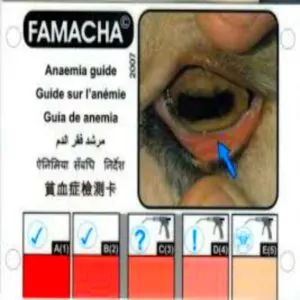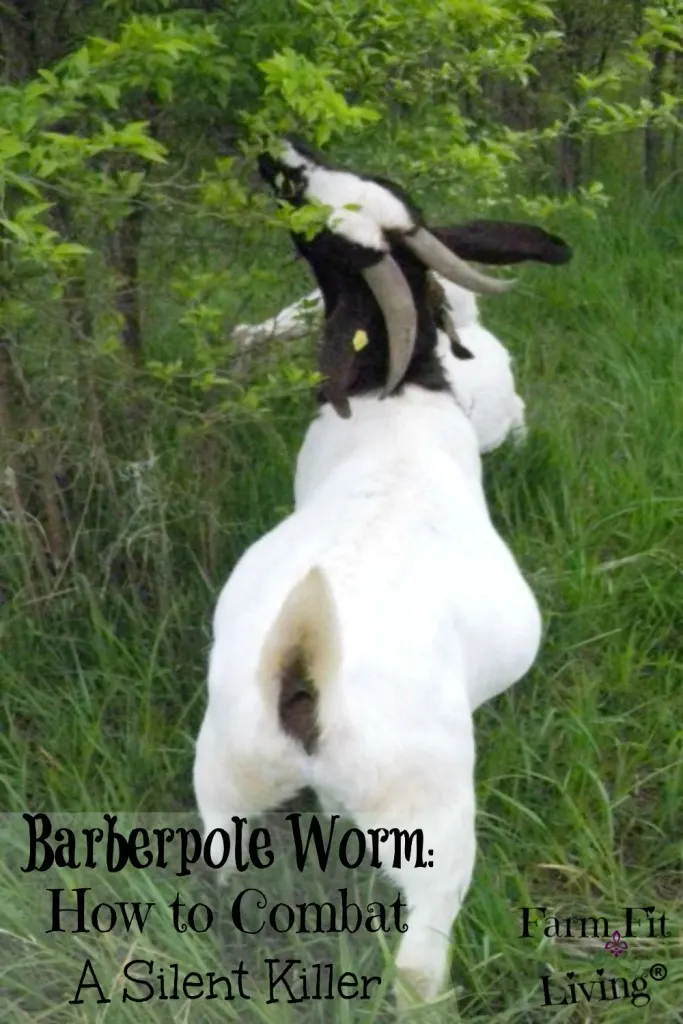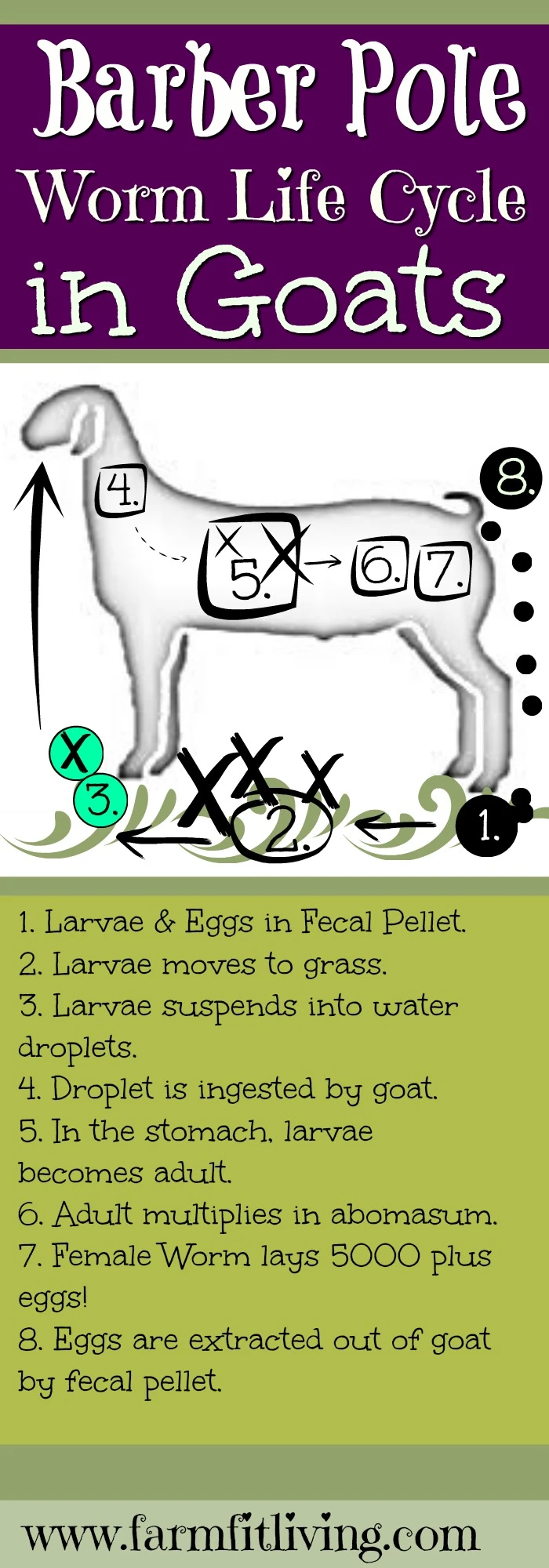There’s so many things I’d like to say to a barber pole worm. But instead, I’ll share the best treatment for barber pole worms for control in meat goat herds.
The best treatment for barber pole worms in goats will give those worms exactly what they deserve…killed.
Ok, so you might think that seems harsh. But, I’m so over these ridiculous stomach worms. You see, the barber pole worm is a silent serial killer that runs rampant through goat herds in the spring and fall months. They are blood sucking parasites. They live in the soil and become alive when the weather turns warmer.
So, for those of us who had an unseasonably warm winter: I hope you enjoyed the weather. The worms sure did! This particular worm is a blood sucking stomach worm that affects all breeds of goats. Therefore, I would strongly suggest that any goat breeder develops a plan for controlling these worms in herds.
Know the signs to combat this silent killer. After 10 years of raising goats, I’ve had my share of run-ins with this nasty parasite in my goat herd. I’m sharing with you what works for me as well as other breeders in the industry in hopes that you can find success in your own herd. Scientifically named “haemonchus contortus, the barber pole worm has causes some significant symptoms you need to be aware of. But first of all, you should understand the haemonchus contortus life cycle.
Listen to the Podcast Episode Here:
This post contains Affiliate Links. This means if you click and buy, I might make a commission at no cost to you.
See my policy for more information
Haemonchus Contortus Life Cycle
Haemonchus Contortus morphology is fairly detailed but simple. First of all, some simple facts about this worm:
– Found in the abomasum (Stomach of the Goat).
– 10-30 mm long.
– 5,000 eggs daily are produced by females!
– Life cycle (egg to mature adult) is 17-21 days.
The following is the entire life cycle in steps:
1. Inside a fecal pellet, there are eggs and larvae present. This is what a fecal test will show as well.
2. The larvae make their way from the pellet into the grass.
3. Larvae becomes suspended in dew or rain droplets.
4. Larvae droplet is ingested as a goat grazes or eats off the ground.
5. Now in the goat’s stomach, the larvae becomes an adult stomach worm.
6. The adult rests, lives and multiplies in the abomasum of goats.
7. Finally, those 5,000 plus eggs are released by the female and extracted out of the goat by way of fecal pellets.
8. And it starts again.
Let’s go into the timing of the process by learning when high loads occur.
Barber Pole Worm Infestations in Goats
So, barber pole worm infestations in goats occur most frequently in the Spring and Fall months. The worms propagate best in simply warm, moist soil conditions. They don’t do well in extreme hot, dry or cold conditions.
Therefore, goat farmers should really appreciate a cold winter as well as a hot summer. These conditions slow down the progress of the larvae tremendously. And when winters are unseasonably warm or summers unseasonably cool, problems occur. Even though cold Winters are hard on barber pole worms, Haemonchus contortus has adapted to overwinter dormant in the abomasum of goats.
So, even though it turns cold, the worms are still there in the stomach of your goats. During this time the larvae do nothing because they are dormant. But when the doe gives birth, barber pole begins to develop as well. Lactating does are unable to control adult populations of barber pole worms. This creates the problem in many herds because the worms are able to produce more eggs to further contaminate pastures and pens.In fact, the most vulnerable time for a goat to be infested by a high worm load is 30 days before or after kidding.
And this is why producers are advised to administer a dewormer after a doe kids. Before you deworm your doe, understand there are better ways to determine if a doe has a certain type of worm.
So, what happens to the worms if you do deworm?
– Many eggs are shed back onto the ground while most stay in the host.
– If the ground is dry, the larvae inside the eggs will die.
– With warmer weather, larvae can become ingested by animals increasing worm load.
Before you choose a barber pole worm dewormer, you really need to know the signs and understand if barber pole is truly what you’re goats are dealing with.
Spot the signs for the Best Treatment of Barber Pole Worms
The first sign haemonchus contortus diagnosis is generally a thin goat. Once you notice the goat isn’t putting on weight, it’s time to check for a more positive and thorough diagnosis.Other symptoms (please don’t wait for these!) include: – Edema (bottle jaw)– Acute anemia– Weak goats– Listless behavior– Death
So, how can you stay on top of these worms before your goat starts to suffer?
FAMACHA System
You can use FAMACHA eye test for an initial color analysis of the inside of the eyelid. Develop the habit of checking the coloration of the inner lower eye membrane. The inner lower eye membrane should be bright red to bright pink. If it is bright pink to white, you know it’s time to treat a worm problem.
FAMACHA has worked pretty well for me over the years and has allowed me to jump on top of problems that could have became worse. Even though FAMACHA is a pretty good indication of a worm infestation, a fecal sample should also be completed. The reason for the fecal sample is to check for infestation of other kinds of worms. Not all wormers will treat the same worm, so it’s important to understand which worm you should be treating for. A fecal sample can determine which worm you need to treat for.
Gathering a fecal sample for fecal egg counts
You will need to gather the freshest fecal sample you can. Wait and watch the goat closely to gather the most appropriate droplets for the fecal test. If you have a microscope or fecal kit and know what you’re looking for, feel free to construct this test yourself. However, many of us do not have this type of equipment. In that case, you should take sample to your veterinarian for proper analysis. For a minimal cost, you can receive very accurate results that will catch immediate problems.
Here are the steps for gathering a fecal sample:
- First of all, obtain a plastic bag like a Ziplock baggie and some disposable gloves.
- Carefully observe your goats. Obtaining a fecal early in the morning when they get up will work well.
- With gloves on, grab some fresh fecal and place it into the baggie.
- Immediately take your baggie to the vet. It needs to be fresh.
- Finally, wait for results. You should hear back from your vet by the end of the day.
Both the fecal sample and the FAMACHA system test will give a comprehensive result for a management strategy to combat barber pole. And now you can start looking into the best barber pole worm dewormer options for goats.
How to Treat Barber Pole Worm in Goats
Once you know which worm to target, it’s time to start combat with a dewormer. You should work with your experienced goat mentor or your veterinarian to choose the most appropriate dewormer.
I have a dosing chart I’ve created that is in my shop that is available to you. You should go get it here.
There are many options out there for dewormers that control barber pole worm. Here are some recommended dewormers along with their classes.
1: Benzimidazole
2: Imadazothiazole/Tetrahydropyrimidine
- Prohibit (Levamisole) – See Your Vet
- Pyrantel Pamoate (Tetrahydropyrimidines)
3: Macrocyclic Lactone:
My veterinarian recommends using two different wormers from two separate classes at the same time. For example: A fenbendazole such as Safeguard and a Lactone such as Cydectin to fight barber pole worm. This combination should be given one day, then 12 hours later and then again 10 days later. Finally, if needed, he recommends coming back with a final round 10 days later.
In order to control barber pole long term, you really shouldn’t rotate your protocol. Also, you should know exactly how much your goat weighs before you start treating with the protocol.
The best thing to do is to use what works for your area.
Safeguard works pretty well in my area of the country as of now, but it does not work at all in other areas. Your veterinarian or expert goat mentor will be able to tell you what works or what doesn’t before you have to find out the hard way.
Most of these dewormers are not labeled for goats, so it’s definitely important to check with a veterinarian before using a dewormer not labeled for goats. You also need to pay attention to withdrawal times if you plan to sell the animal after deworming.
Finally, a liquid dewormer drenched orally per individual goat is the best way to deworm an animal. There are feed and water dewormers out on the market, but they typically don’t do as good of a job as deworming individually.
Based on my experience, I would also recommend giving several doses of probios after deworming. While the dewormer is effecting the stomach worms, it’s also killing good bacteria in the stomach. Probios will give the good bacteria the jump start it needs to keep the goat healthy.
Working with your veterinarian and expert goat mentor immediately after finding a problem can prevent future problems down the road.
Constant problems
Two major conditions can stem from the infestation of barberpole worm:
- Bottle Jaw
- Anemia
Bottle Jaw is a condition caused by the worm that is less threatening. It can lead to the onset of severe anemia if not properly treated. As the worm continues to suck the blood of the goat, anemia develops. This condition can be life threatening and many goats die due to anemia. Until the goat is deathly ill and usually too far gone to be saved, the animal will continue to eat and eat and eat . . . all the while losing ground to the damage being caused by the stomach worm. An animal that is severely anemic will need far more help than just deworming. Suzanne of Onion Creek Ranch has a great article about treating anemia.
Adaptability and Control
Adaptability takes many years of proper management, pasture rotation and culling problem goats.The main problem can be controlled in how you feed goats. They eat from the top down to protect themselves. This is why they need plenty of browse and high ground vegetation to consume daily. Grazing short pastures will result in a higher worm load and fecal egg counts because the stomach worms are sitting in the warm soil just waiting to be sucked in by your goat.I have found that pasture rotation and very low stocking rate does help in controlling stomach worms. Grazing with cattle has been proven to improve parasite load.
Stocking rate is another factor to keep in mind.
Each area of the country requires a different stocking rate. This stocking rate depends on existing parasite loads, amount of vegetation, and number of acres. Weather conditions and rainfall should also be factored into this equation to ensure plenty of proper nutrition. Still, keep an eye on your herd because the goats need time to adapt to a new area.
If you’ve moved a goat to your home from another area, it will take a while for this goat to adapt. Do not assume the goat or other small ruminants will be immune to problems. Always be proactive in checking. Keep in mind that all goats need months to adapt to a new location.
No goat is resistant to worms of any kind.
A more appropriate word I like to use is tolerant. I do have goats I’ve hardly ever had to deworm because they are more tolerant. Don’t think I don’t check them still! Those are the ones I’ve kept for years and years and continue to grow with.
I have also had goats I have to deworm more often. They are more susceptible to worms and this can create a problem. These goats eventually are sold to make room for better, more tolerant genetics.
Regularly scheduled FAMACHA readings and fecal counts are critical to inform you which goats are productive and to keep your herd healthy.
Management is the key to combat stomach worm
While I can’t actually talk to the barber pole worm, I know I can control it with proper management and best treatment for barber pole worm in goats. Management is critical.FAMACHA, fecal samples and stocking rate on browse land are only a few ways to manage and control deadly stomach worm. And while their is no barber pole worm vaccine on the market, there are plenty of wormer options to attempt if you suspect barber pole worm.
So, now you know how to treat barber pole worm in goats.
Continue to spot the signs with your naked eye, treat appropriately and be proactive with prevention strategies, such as pasture rotation. See below for more in-depth prevention tips. The war with Barber pole is never ending. But, now is the time to learn and apply management practices to combat the problem once and for all. Plus, you now have some barber pole dewormer options for goats. I hope you have gained some tips about barber pole worm treatment in goats you can implement into your herd to control the nasty barber pole worm.
More On Prevention Tips for Haemonchus Contortus Overload
I’m not finished yet. Let’s talk more about prevention.
I’ve been studying and attending classes on this topic for YEARS. I have my own methods of prevention I use within my goats (and sheep) flocks that I want to share with you today. Here they are in a list:
A) Understock
B) Feeding Up Off the Ground
C) Promote Low Stress
D) Regular Scouting of your Herd
E) Grazing with Other Species
Here I’ll dive deeper into each one:
A) Do Not Keep Too Many Goats Together
The #1 way to prevent barber’s pole worms in goats is…Understock. Do not put too many goats (especially young animals) in one paddock or pen. Stocking rate from area to area WILL vary depending on the amount of green stuff that’s in there. Understocking will help prevent overgrazing, but it also helps limit the amount of fecal material that contain the worm load.
B) Feed the goats up off the ground
The second way to help prevent Barber Pole Worms in goats is to feed off the ground. Goats naturally feed off the ground in the form of browsing anyway but if shrubs and leafy trees aren’t available, then they will graze on the ground and be more susceptible to internal parasites load. Also, if you’re feeding a mineral or a feed, you need to make sure that containers stay clean from poop that could contain a worm load.
Check containers daily or as often as you can. It is really important to keep the containers clean because the infective larvae are in the poo and will live by sitting in the bottom of the container or in your goats’ feed or mineral.
Don’t forget about Water as well! Goats will poo in the water and you don’t want them drinking that! Be sure you’re checking the water containers on a daily basis if you can. Goats should have fresh clean water every single day.
C) Watch out for Stress
Thirdly, stress makes goats susceptible to higher worm load. All of the above methods I’ve mentioned (Understocking and feeding off the ground) will help keep them happy, healthy and low stress.
How do you know when your goat is stressed?
Some signs of a goat being stressed include:
1) Droopy Tail and ears.
2) Moping or just laying around.
3) Crying for (something) when they see you.
4. External Parasites, such as Mites, Lice or Ringworm
Environmental Conditions, such as Weather Conditions can also cause stress. These are things we can’t always keep from happening but a good shelter can help the goats feel safe, secure and warm.
Another way to minimize stress is to make sure your goats are meeting their peak nutritional needs. Copper and B-Vitamins are a the top of this list. A lot of goat farmers use copper boluses to supplement copper or you can use a goat loose mineral with Copper. Notice you’ll start to see their hair looking better when their copper needs are met.
It’s super important to look at your goats every day and make sure they aren’t stressed. Stress promotes increased worm loads and affects their immune systems. Let’s talk about scouting next.
D) Check Your Goats Regularly
Regular Scouting is very important with your goat herd. If you just put your goats out in a pen and forget about them, you miss out on signs that could keep you from catching problems quickly.
When I scout, I take treats along with me so they will come up to me. This allows me to get close to them and really look them over for not only internal parasites but clinical signs of external parasites, such as lice or mites. I also use my FAMACHA card to see if they are becoming Anemic. More often than not, they are fine but it makes me feel at ease to know that I’m in control with knowing the health status of my herd.
How often do I check my herd?
Well, really as often as I can. Life gets busy but whenever I go to see my goats, I’m checking for those things. Since I love my goats and I love going to see them, it’s usually not an issue. But I’m also a mom to 3 busy kids plus I have several different jobs for income…So, I’m busy just like you are. We can all just do our very best but REMEMBER that it’s a matter of doing what you love and the goats are what I love. I love going to see them – It brings me happiness.
E) Graze with Cows and Sheep
Finally, I think Multispecies Grazing helps to manage barber pole worm load. Specialists have researched and taught over the years that grazing goats after cattle will decrease the parasite load. I’m not convinced that there is NO internal parasites load – But I do believe that multispecies grazing slows it down.
I have highlighted the art of Multispecies Grazing in a whole ‘nother post that you can find here. It is a lot of work to set up due to fence building different paddocks and the moving around of animals but it is soo good for your land.
In a nutshell, the different species of livestock choose and eat differently. Also, based on studies from researchers, cattle ingest the adult worms and larvae that affects the goats. Kind of like a vaccum.
So, a really great schedule would be: Grazing sheep, then Cattle, then let the goats come in and clean up the rest. Again, it’s a really great way to get the most out of your pasture area as well.
The thing to remember about this entire topic as a whole is that your goats already contain parasites naturally. So, no matter if you follow all of the prevention strategies I’ve mentioned, you’re bound and determined to still have a goat get a barber pole overload.
Before that happens, go grab my printable dewormer chart here so that you’re ready.








Brett
Wednesday 21st of November 2018
Very informative. You have 60 head on how many acres?
Mindy Young
Wednesday 21st of November 2018
Hey Brett. We have 40 acres of pasture where we live. The goats are always on that 40 acres.
Skeeter
Friday 5th of October 2018
I read that the proper copper dosage can kill them as well.
Mindy Young
Saturday 6th of October 2018
Hey, Skeeter ~ If goats don't need the extra copper, there's no need to give them more. It's why I love the loose mineral. They consume what they need with it. If you must copper bolus, do that first and then put some mineral out.
10 Top Busting Myths About Goats to Know
Wednesday 18th of April 2018
[…] For further info on controlling barber pole worms, go here. […]
23 Unique Gifts for Goat Lovers
Sunday 15th of October 2017
[…] Read how to combat barber pole worms. […]
Kelly Verdel
Wednesday 9th of March 2016
What age is it okay to start giving the dewormer if needed? I haven't been able to find that anywhere and though we currently don't have a problem, I am curious as we are still pretty new to having goats (less than a year) and our girls freshened 3 weeks ago...
Mindy Young
Wednesday 9th of March 2016
Hi, Kelly! I usually don't give dewormer to kids until they are at least 4 months old. But, it depends on your area and and worm load. We have found that we deworm less and less each year since we rotate our pastures.